Coordinación
Una coordinación sólida puede evitar vacíos y duplicaciones en las respuestas humanitarias, así como garantizar que los PTM complementen otros tipos de asistencia. Sin embargo, el informe del «Estado Global de los Programas de Transferencias Monetarias» de la CALP Network muestra que la coordinación de la asistencia en efectivo es vista como débil y ad hoc, y que esto está teniendo graves repercusiones operativas.
Los donantes, las ONG y los líderes de los grupos de trabajo de transferencias monetarias (GTM) han pedido claridad sobre tres temas principales relacionados con la coordinación de la asistencia en efectivo:
- Quién debe ser responsable de asegurar una coordinación eficaz de la asistencia en efectivo;
- Cuál es la función y el mandato de los grupos de trabajo de transferencias monetarias, incluso en relación con las transferencias monetarias multipropósito;
- Cómo se debe dotar de recursos a la coordinación de asistencia en efectivo.
Tenemos que basarnos urgentemente en lo que funciona y proporcionar claridad a nivel mundial sobre las preguntas arriba mencionadas, adaptándonos a los diferentes contextos. Hace mucho tiempo que se deberían haber tomado decisiones claras basadas en necesidades operativas y no en la política de las agencias.
Prioridades actuales
El objetivo de la CALP Network es contribuir a seguir progresando en este tema en tres niveles: apoyar a los grupos de trabajo de transferencias monetarias a nivel regional; contribuir a soluciones prácticas para la coordinación de la asistencia en efectivo a nivel mundial; y convocar una discusión basada en la evidencia sobre temas clave, destacando puntos de decisión críticos y oportunidades de progreso.
Contenido destacado
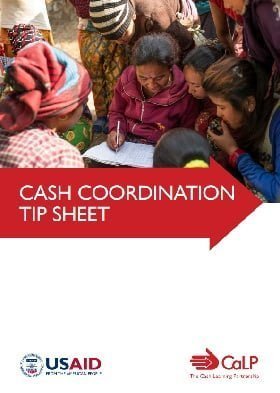
Cash Coordination Tip Sheet
Guidelines and Tools
This tip sheet sets out established best practice, key guidance and resources for all aspects of cash coordination, intended as a clear, accessible and action-oriented guide for those engaged in coordination of cash and voucher assistance (CVA) at the field level.
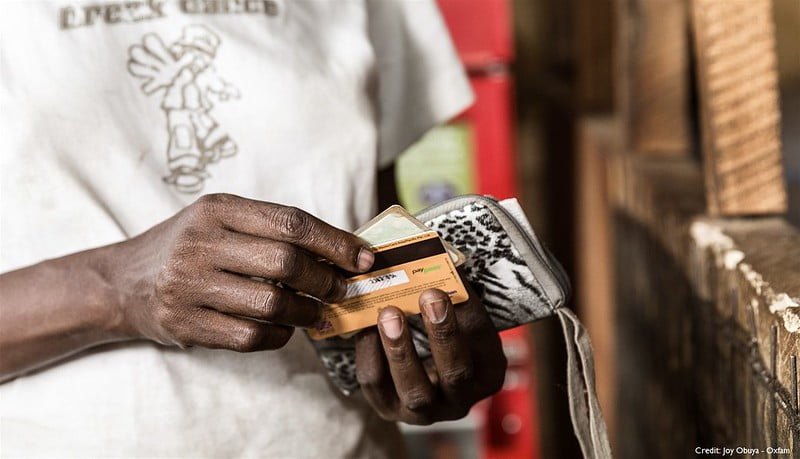
Introducing the Cash Coordination Tip Sheet
Webinar
The CALP Network has developed a tipsheet setting out established best practice and key guidance and resources for all aspects of cash coordination, intended as a clear, accessible and action-oriented guide for those engaged in coordination of cash and voucher assistance at the field level.

Cash Coordination: A proposal from members in MENA
Blog Post
Earlier this year the CALP Network undertook regional consultations to explore options for cash coordination. This blog lays out recommendations from participants from the Middle East and North Africa who sketched out what cash coordination, and coordination more broadly, could look like in future to support a more effective, efficient and accountable response.
Últimos recursos
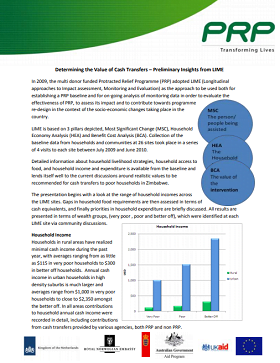
Determining the Value of Cash Transfers – Preliminary Insights from LIME
Report
In 2009, the multi donor funded Protracted Relief Programme (PRP) adopted LIME (Longitudinal approaches to Impact assessment, Monitoring and Evaluation) as the approach to be used both for establishing a PRP baseline and for on-going analysis of monitoring data in order to evaluate the effectiveness of...
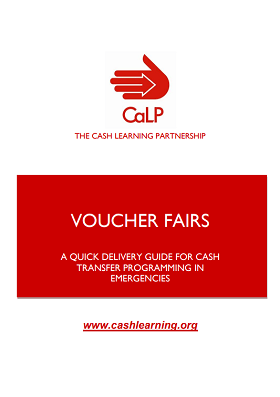
Voucher Fairs: A Quick Delivery Guide (screen version)
Guidelines and Tools
A Quick Delivery Guide to using voucher fairs to implement a market-based emergency response. Prepared as a practical tool, this guide provides a brief synthesis of the necessary preconditions and advantages and disadvantages of using voucher fairs. It also provides practical implementation tips.

Support to Economic Recovery of Urban Households in Karoi town, Zimbabwe (the CALP Network Case Study)
Report
In the urban area of Karoi, Zimbabwe, Save the Children combined cash for work with livelihoods support to meet the immediate food needs and support the economic recovery of poor families. The project used smart cards to transfer cash to beneficiaries, which proved to be an appropriate payment...

Informe de Buenas Prácticas (GPR) 11: Programas de transferencias de efectivo para emergencias
Informe
Este GPR sintetiza directrices sobre transferencias de efectivo previas, concentra conclusiones extraídas de ciertas investigaciones y evaluaciones y añade ejemplos prácticos de intervenciones basadas en efectivo. Una de las dificultades que entraña escribir sobre respuestas basadas en efectivo es...

Case Study of Cash Transfer to Traders during the Pakistan Earthquake of 2005
Case Study
This case study examines Oxfam’s innovative programme to provide cash/vouchers to local traders to re-establish their businesses and re-initiate an economic stimulus in order to help vulnerable people purchase, or put on credit, food and non-food items throughout the upcoming winter. The paper looks at...
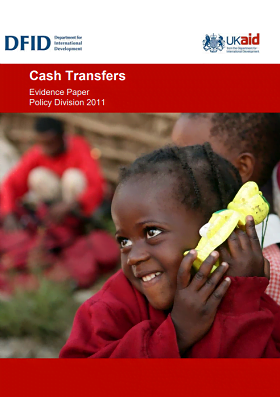
Cash transfers: Evidence paper
Report
This DFID evidence paper provides a synthesis of current global evidence on the impact of cash transfers in developing countries in achieving a range of social and economic policy objectives. It examines design and implementation choices for tailoring programmes to particular objectives, notably social...
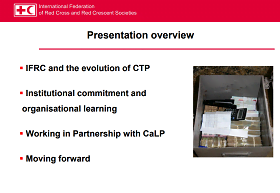
IFRC and the evolution of CTP
Presentation
An IFRC presentation covering the following topics: IFRC and the evolution of CTP Institutional commitment and organisational learning Working in Partnership with the CALP Network Moving forward
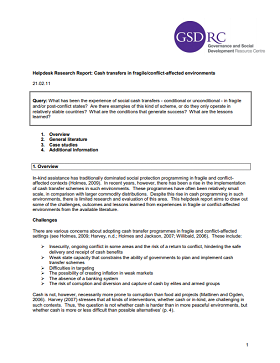
Helpdesk Research Report: Cash Transfers in Fragile/Conflict-Affected Environments
Report
In-kind assistance has traditionally dominated social protection programming in fragile and conflict-affected contexts (Holmes, 2009). In recent years, however, there has been a rise in the implementation of cash transfer schemes in such environments. These programmes have often been relatively small...

Emergency Livelihood Recovery Intervention (ELRI): Fafi District – Garissa County – North Eastern Kenya
Report
The Emergency Livelihood Recovery Intervention (ELRI) was implemented by Horn Relief with funding from OFDA. The Emergency Livelihood Recovery Intervention (ELRI) took place between January 2010 and April 2011; it was designed to address the immediate food security needs of the drought-stricken population...
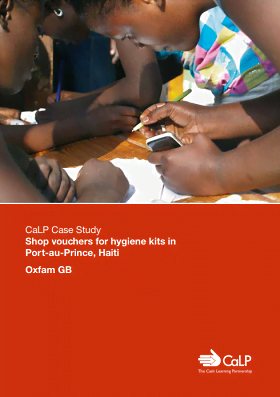
Shop vouchers for hygiene kits in Port-au-Prince, Haiti (the CALP Network Case Study)
Report
In the aftermath of the 2010 Haiti earthquake, Oxfam’s Public Health Promotion team used a voucher programme to provide beneficiaries with essential hygiene items through local shops. The voucher system was chosen so that beneficiaries could access hygiene items in a normal and dignified way, and in...

The Voucher programme in the Gaza Strip – Mid-term review
Report
The WFP voucher project is part of the emergency operation (EMOP 10817.0) to assist the recovery of the population affected by the conflict in Gaza Strip. WFP emergency operation has the following objectives: Meet urgent needs and improve the food consumption for conflict-affected people targeted...
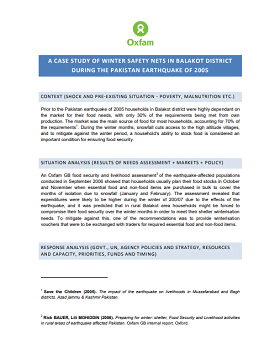
A Case Study of Winter Safety Nets in Balakot District during the Pakistan Earthquake of 2005
Case Study
This case study looks at Oxfam’s response to the Pakistan earthquake and the upcoming winter by providing winterisation vouchers to vulnerable households to be exchanged with traders for required essential food and non-food items. The paper looks at the context, situational analysis, response analysis,...
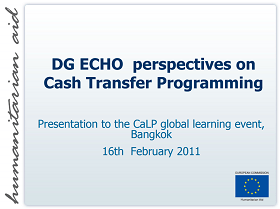
DG ECHO perspectives on Cash Transfer Programming
Presentation
A presentation accompanying the CALP Network global learning event, Bangkok 16th February 2011, covering the following topics: DG ECHO position on the use of Cash &Vouchers (C&V) Trends in funding C&V projects Using C&V at scale: the case of Haiti Capacity building priorities
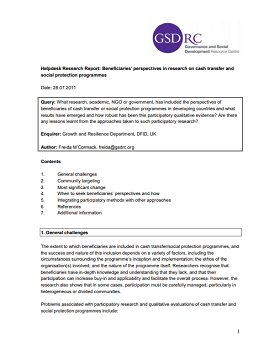
Helpdesk Research Report: Beneficiaries’ perspectives in research on cash transfer and social protection programmes
Report
Query: What research, academic, NGO or government, has included the perspectives of beneficiaries of cash transfer or social protection programmes in developing countries and what results have emerged and how robust has been this participatory qualitative evidence? Are there any lessons learnt from the...
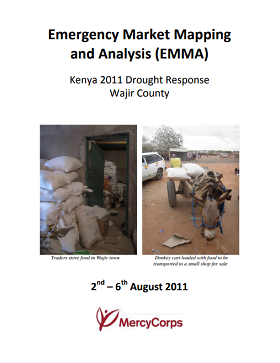
EMMA – Wajir, Kenya
Report
Mercy Corps conducted an adapted Emergency Market Mapping and Analysis (EMMA) assessment in Wajir County of Kenya from 2-6 August 2011. The assessment was organized as a response to the hunger crisis resulting from the worst drought in the region in the last 60 years. The EMMA methodology was adapted...
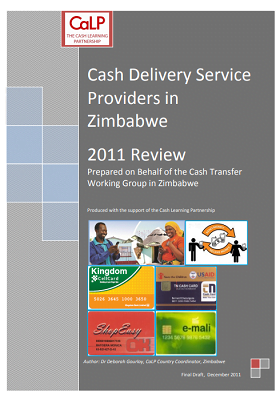
Cash Delivery Service Providers in Zimbabwe
Report
Over the past few years Zimbabwe has witnessed a significant increase in the use of cash transfers within policies and programs providing humanitarian aid. This has resulted is an increasing desire on the part of humanitarian agencies to partner with private sector financial service providers in the...

Oxfam Programme Quality Standards: Cash transfer programmes (CTPs)
Guidelines and Tools
Through its Emergency Food Security and Vulnerable Livelihoods (EFSVL) work, Oxfam aims to meet immediate food needs and protect livelihoods, whilst contributing to the longer term economic recovery of disaster affected populations and increasing their resilience to future shocks. Oxfam believes that...
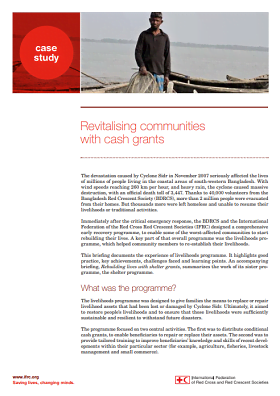
Revitalising communities with cash grants
Case Study
This case study gives an overview of the Red Crescent’s response programme in Bangladesh following the devastation caused by Hurricane Sidr in 2007. Part of the overall programme was the livelihoods programme, which helped community members to re-establish their livelihoods. The programme focussed on...

Korogocho Cash Transfer Initiative: Supporting ‘Transformative Social Protection’ in the Kenyan Urban Slums
Case Study
This case study looks at Concern Worldwide’s work with the Kenyan government to introduce the concept of transformative social protection (which acknowledges that vulnerability is not only related to income, and seeks to complement cash transfers with components addressing further vulnerabilities) to...
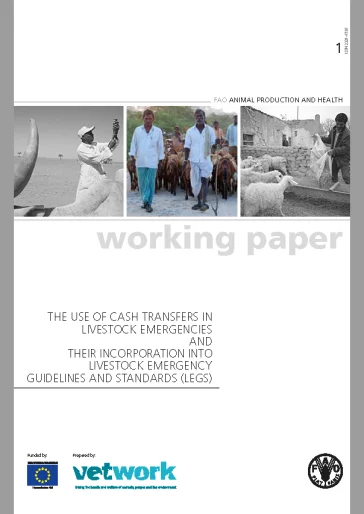
The Use of Cash Transfers in Livestock Emergencies and their Incorporation into Livestock Emergency Guidelines and Standards (LEGS)
Guidelines and Tools
This paper reviews the use of cash transfers within the livestock sector and suggests how they can be incorporated into and support Livestock Emergency Guidelines and Standards (LEGS). The paper’s structure reflects the stages of the LEGS Handbook as these in turn reflect good project cycle management....